
Introduction
Are you tired of typing on the same keyboard on your Android device? Do you wish to have more options and functionalities while typing out your messages or emails? You have come to the right place!
In this article, we will explore how to change the keyboard on an Android device, along with all the features and benefits that come with the change. Whether you’re looking for improved typing speed, quick language switching, or an entirely different look, this guide has got you covered.
Step-by-Step Guide
Changing the keyboard on an Android device may seem daunting at first, but it’s a simple process. Here are the steps:
- Go to your phone’s settings.
- Select “System”.
- Select “Languages & input”.
- Select “Virtual keyboard”.
- Select the keyboard you want to use from the options available.
- Enable the chosen keyboard.
- You’re good to go!
For a more visual guide, check out this video:
Following these steps will give you access to the new keyboard on your Android device.
App-Based Solutions
If you want more options to choose from or additional features, there are several apps available for download that can change the keyboard on your Android device.
Three popular apps include:
- Gboard: a Google-owned keyboard that allows for effortless switching between typing and voice dictation. It also has features like integrated Google search, GIF support, and emoji search.
- Swiftkey: a keyboard that adapts to your typing style, making it easier to type faster and more accurately. It boasts features like built-in GIF and sticker search, multilingual autocorrect, and personalized predictions.
- Fleksy: a keyboard with unique gestures and customizable themes. It also has features like GIF and sticker search, multilingual typing, and a built-in Mini-apps feature for quick access to various tools.
These apps offer more options and are easily accessible through the Google Play Store on your phone.
Android Keyboard Settings
Android devices come with several keyboard settings that users may not be aware of. Here are a few settings available without downloading additional apps:
- Text correction: This option corrects typos and suggests words for users while typing.
- Auto-capitalization: This automatically capitalizes the first letter of sentences.
- Auto-correction: This automatically corrects spelling mistakes while typing.
- Personal dictionary: This allows users to add words specific to their dialect or language that the default dictionary may not recognize.
These settings can be accessed under the “Virtual keyboard” option in “Languages & input” in the device settings.
Benefits of Using Third-Party Keyboards
While the default keyboard on Android devices serves its purpose, there are several benefits of using third-party keyboards:
- More features: Third-party keyboards come with unique features, such as swipe typing, autocorrect, and gesture controls that may not be available on the default keyboard.
- Customization: Users can customize the keyboard to their liking by changing the background, font, and key layout to suit their taste.
- Languages: Third-party keyboards offer more language options to choose from, making it easier for multilingual users to communicate without having to switch keyboards constantly.
Some popular third-party keyboard alternatives include:
- Gboard: This is a popular keyboard developed by Google that comes with features like GIF support, integrated search, and voice dictation.
- Swiftkey: Swiftkey is a keyboard that adapts to your typing style, providing personalized predictions and multilingual autocorrect options.
- Fleksy: Fleksy offers unique gestures, themes, and quick access to various Mini-apps like web search, launchers, and calculators.
These are just a few of the many third-party keyboard options available to Android users that are worth considering.
Language Switching
For users who need to type in multiple languages, third-party keyboards provide an easier solution. Users can switch between languages utilizing the same keyboard. In most cases, the user types in the desired language directly without having to change the keyboard.
Typing Shortcuts
Tips and tricks associated with typing faster on an Android keyboard include using keyboard shortcuts. Here are a few popular ones:
- Double-tap spacebar: This puts a period at the end of the sentence and capitalizes the next letter automatically.
- Swipe typing: This feature allows users to type out words by swiping over each letter they want to type without lifting their finger until the next word comes up.
- Voice dictation: This feature lets users dictate text instead of typing for faster and more accurate typing, but it requires an internet connection.
Using shortcuts like these can help you type out messages and emails in half the time.
Troubleshooting
While changing your keyboard on an Android device is a straightforward process, sometimes users may run into issues. Here are a few common problems and solutions to troubleshoot them:
- Keyboard didn’t appear: If the keyboard doesn’t appear, try restarting your device or clearing the cache in the application settings.
- Keyboard lagging: If the keyboard is lagging, try clearing the cache or disabling any unneeded features.
- Keyboard settings option not functioning properly: If the keyboard settings option isn’t working, try restarting your device or clearing the cache in the application settings.
If these solutions do not work, users may need to uninstall and reinstall the keyboard application.
Conclusion
Changing the keyboard on your Android device may seem daunting at first, but it’s a simple process. In this article, we have covered a step-by-step guide to changing your keyboard, app-based solutions, Android keyboard settings, benefits of using third-party keyboards, language switching, typing shortcuts, and troubleshooting tips.




